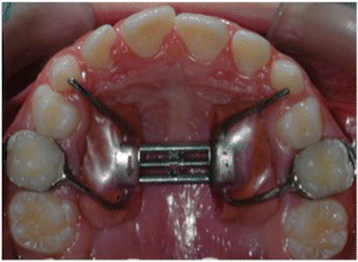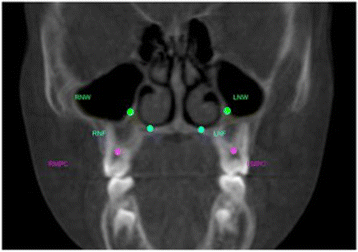Digital evaluation of nasal changes induced by rapid maxillary expansion with different anchorage and appliance design
- PMID: 28705206
- PMCID: PMC5513127
- DOI: 10.1186/s12903-017-0404-3
Digital evaluation of nasal changes induced by rapid maxillary expansion with different anchorage and appliance design
Abstract
Background: Scientific evidence showed that rapid maxillary expansion (RME) affects naso-maxillary complex, increasing nasal width and volume. This study aimed to evaluate nasal changes induced by rapid maxillary expansion with different anchorage and appliance design by using low dose and cone beam computed tomography.
Methods: A total of 44 patients (20 males, mean age 8y 8 m ± 1y 2 m; 24 females mean age 8y 2 m ± 1y 4 m) were included in the investigation and divided into three groups according to the appliance: Hyrax-type expander anchored to permanent teeth, modified Hyrax-type expander anchored to deciduous teeth, modified Haas-type expander anchored to deciduous teeth. Maxillary expansion was performed until overcorrection and the expander was passively kept in situ for 7 months at least. All patients had three-dimensional imaging before expansion (T0) and after the retention period (T1). Nasal floor width, nasal wall width, maxillary inter-molar width were measured by means of Mimics software. The paired sample t-test was employed to assess the significance of the differences between the time points; the analysis of variance test (ANOVA) was used to compare differences between groups.
Results: The statistical analysis revealed significant differences between T0 and T1 for each recorded measurement in each group; no significant differences were found by comparing groups.
Conclusions: Rapid maxillary expansion produces a significant skeletal transverse expansion of nasal region in growing patients. No significant differences in nasal effects are expected when the appliance is anchored onto deciduous teeth, with or without the palatal acrylic coverage.
Keywords: Cone beam computed tomography; Low dose computed tomography; Nasal cavity; Rapid maxillary expansion.
Conflict of interest statement
Ethics approval and consent to participate
Signed informed consent was available from parents of patients for releasing diagnostic records for scientific purposes. Protocol was reviewed and approved by the Ethical Committee of the University of Insubria, Varese, Italy (Approval no. 826) and procedures followed adhered to the World Medical Organization Declaration of Helsinki.
Consent for publication
Not applicable.
Competing interests
The authors declare that they have no competing interests.
Publisher’s Note
Springer Nature remains neutral with regard to jurisdictional claims in published maps and institutional affiliations.
Figures





References
-
- Portelli M, Matarese G, Militi A, Lo Giudice G, Nucera R, Lucchese A. Temporomandibular joint involvement in a cohort of patients with juvenile idiopatic arthritis and evaluation of the effect induced by functional orthodontic appliance: clinical and radiographic investigation. Eur J Paed Dent. 2014;15(1):63–66. - PubMed
MeSH terms
LinkOut - more resources
Full Text Sources
Other Literature Sources

